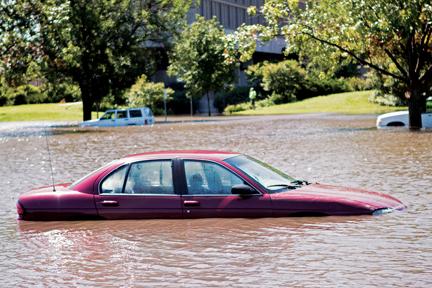Climate models indicate weather, flooding patterns

Photo: Manfred Brugger/Iowa State Daily
Cars sit in the flood waters in the MWL parking lot on Wednesday, Aug. 11.
August 31, 2010
As the city of Ames works to prevent future floods like the one last month, Gene Takle, professor of agronomy and geological and atmospheric studies, said it is important to look at climate models for trends in weather patterns.
“We have confidence that these models do represent events of past climate over the 20th century,” Takle said. “We then use these models to look into the climate in the 21st century; we don’t know a lot of things about the future, but we can make estimates.”
These estimates involve projecting different scenarios. One scenario involves the population continuing to use energy and resources at the same rate. Another scenario measures a more energy-efficient population.
“For all of these scenarios, one of the things that these models show is that there will be more intense rainfall events in central U.S.,” Takle said.
These intense rainfall events are likely due to the climate being warmed, Takle said.
“When the atmosphere heats up this way, it’s like putting more fuel in the fire,” Takle said. “It just speeds up everything and makes for more intense rainfall events.”
William Gallus, professor in geological and atmospheric sciences, said global warming is a controversial issue.
“You can never say that any one weather event is related to climate change,” Gallus said, “but you can say that climate change should bring heavier bursts of precipitation to this part of the country. So it is likely with climate change that there will be increased chances of having floods like we just had in the future.”
The concept of global warming in relation to increased rainfall, Gallus said, is that as the planet heats up, it will evaporate more water from the oceans and lakes.
As the air gets warmer, the amount of water vapor it is able to contain increases, which can result in heavier amounts of rainfall. Flood events, like last month’s, require a weather system parking out over a single area, Gallus said.
“You have lots of wind coming from the Gulf of Mexico with lots of moisture,” Gallus said, “and because the weather system is pretty much sitting there, you can keep creating thunderstorms over and over, hitting the same places, which is really what happened in Ames.”
Takle said rain “run-off” occurs when the soil stops absorbing water, usually when an area receives more than about 1-and-one-fourth inches of rain.
“More of our rainfall is coming in these rainfall events that are more than 1 inch and a quarter,” Takle said, “and if these come back-to-back like they did in August, there’s certainly a chance that it will lead to flooding.”
Gallus said one of the remarkable things about Ames’ flood is that it occurred in August. Floods typically occur earlier in the summer, because the ground retains a lot of moisture from the winter’s melted snow and the crops are immature and unable to use the excess water.
“By August, the crops are usually using lots of water,” Gallus said. “The ground is usually getting pretty dry, so the fact that we had our worst flood in August just shows how incredible the amount of rain was that we got.”
Takle says a longer growing season is another indication of climate change.
“Farmers may tell you they don’t believe in climate change,” Takle said, “but they’re planting corn on the 15th of April. Fifty years ago they would start planting maybe the 10th of May.”
Besides increased rainfall, other effects of global warming include more frequent heat waves, bigger snowstorms in the winter and more droughts.
“It may make the pattern of rainy days and dry days get more extreme,” Gallus said. “You’ll have longer periods without rain and then when it does rain, it will rain harder.”
These extremes make it difficult to find solutions which will prevent events like flooding.
“We can’t say if we get a drought next year, that we can quit planning for floods,” Takle said. “You should think about making your community resilient and that means making it stand up to a variety of extreme events.”
The city of Ames has been making an effort to prevent these extreme events, including reconsidering their policy on building on flood plains and discussing whether or not to put up levees, Takle said.
“After the 1993 flood, they made several changes to the Hilton Coliseum,” Takle said. “Those changes worked, but it’s just that the flood we had this year had different characteristics than the 1993 flood.”
Takle said there are a number of solutions to flooding, but they are complicated and expensive and carry consequences if reverse extremes, such as drought, were to occur.
“I would admonish people to think carefully about this and not jump to quick conclusions to either discount climate change or to blame climate change, but to just be observing,” Takle said. “Remember this event, and think next year and the year after and the year after: Is there anything unusual going on? Are we continuing to get these unusual events, and if so, what is the cause?”






